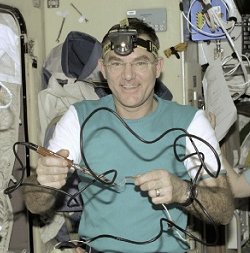|
Research aboard the space station is adapting a tried-and-true
repair tool, the soldering iron, to weightlessness.
by Patrick L Barry
Even on the advanced
spacecraft of the future, sooner or later things are bound to break.
Space travellers on an extended mission to Mars, for example, would
need to be ready to do small repairs just in case, soldering this,
welding that.
In the unforgiving environment of space, a successful solder-repair
to, say, navigation hardware or an oxygen pump could mean the difference
between life and death.
"Surprisingly, relatively little
is known about the unique physics of soldering in microgravity,"
says Richard Grugel, a scientist at NASA's Marshall Space Flight
Center who specializes in the solidification of metals.
To learn more about it, Grugel
and his colleagues Fay Hua of Intel Corporation and A.V. Anilkumar
of Vanderbilt University have planned an experiment for the International
Space Station called the "In Space Soldering
Investigation" (ISSI). They hope the experiment will
shed new light on the physics of soldering and, in the process,
make the soldering iron a more reliable tool for astronauts.

Astronaut
James Voss uses a soldering iron onboard the International
Space Station.
|
Melted solder behaves differently
in space. In the microgravity aboard a spacecraft, molten solder
doesn't "feel" a downward pull as it does on Earth, so surface
tension becomes more prominent and causes blobs of liquid solder
to flow differently. In other words, soldering techniques that work
on the ground may not form proper joints in orbit.
Even worse, those soldered joints
could be much weaker in orbit. Gas bubbles in the molten solder
that often rise to the surface and disappear on Earth can remain
suspended within the liquid in orbit. That's because the pull of
gravity is the force behind buoyancy, so in microgravity bubbles
don't necessarily rise. These tiny bubbles become trapped within
the solder as it solidifies, making the joint less effective and
more prone to breakage - not a good thing when you're in the mission-critical
environment of space!
"How prevalent are these gas bubbles in joints soldered in space?
We need to find out, and perhaps find some way to get those gas
bubbles out so that we can make good joints that won't break," Grugel
says.
The experiment is straightforward: metal wires will be soldered
together in various arrangements, reflecting common geometries important
for making repairs. Space station crewmembers will use a soldering
iron to join these wires with lead-tin solder.

Image
courtesy NASA.
A
scanning electron micrograph of solidified solder on a
wire. The precise angle at which the solder meets the
wire is driven by forces such as surface tension, gravity,
and wetting of the wire. Removing the effects of gravity
lets physicists better understand these other influences.
|
While the shuttle fleet is grounded,
room for sending research equipment and materials up to the space
station is severely limited. The ISSI experiment was selected in
part because it requires no "up-mass" sent to the station from the
ground. The space station already has a soldering kit onboard and
coils of silver-coated copper wire.
The Expedition 7 crew,
which returned to Earth in 2003, fashioned the wire into L-shapes,
loops, parallel threads, and other shapes in preparation for the
experiment to be performed during Expedition 8 which lasted until
April 2004.
While the experiment
happened, the researchers were able to watch it unfold live at NASA's
Telescience Center at the Marshall Space Flight Center in Huntsville,
Alabama. Watching to see the differences in how the solder flows
and the shapes it assumes in space, which offers clues to the fundamental
physics of molten solder.
The live interaction
allowed them to suggest procedure changes to the station crew members
in real-time. After the samples are returned to Earth, the scientists
will cut open the joints to see how many gas bubbles were trapped
during the process, and they'll test how strong the joints are.
"We should be able to gain a window into how surface tension effects
soldering in microgravity," Grugel says. "This will help lay a foundation
for the future of in-space fabrication and repair."
|
